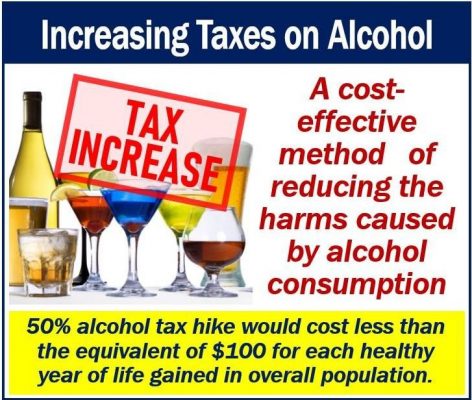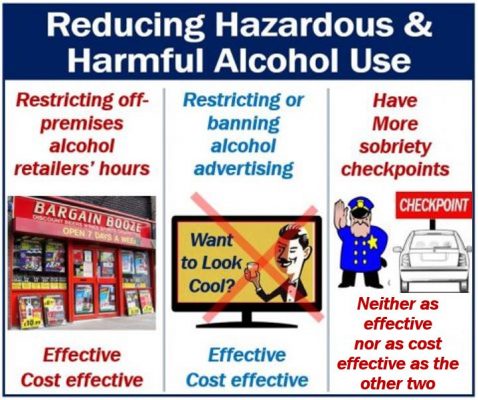Raising alcohol taxes is a very cost-effective way to reduce alcohol-related harms, a team of researchers says. Restrictions on hours of sale and alcohol advertising are also very effective in reducing harmful and hazardous alcohol use.
Not only do these measures help reduce alcohol harms, but they also help improve overall health in the population.
Dan Chisholm, Ph.D., and colleagues wrote about their study in the Journal of Studies on Alcohol and Drugs (citation below). Dr. Chisholm works at the Department of Mental Health and Substance Abuse at the World Health Organization in Geneva, Switzerland. The article’s co-authors work in Switzerland and several centers in Canada.
Dr. Chisholm said:
“Tax increases may not sound the most attractive of policy options but are the single most cost-effective way of diminishing demand and reining back consumption.”
The researchers used a statistical model to determine which alcohol control strategies were best. Specifically, strategies that were cost-effective in reducing harms and deaths from alcohol consumption.
They looked at five alcohol control strategies.
The authors quoted previous studies which indicated that at least 5% of deaths globally were directly alcohol-related. Also, studies showed that four percent of the overall disease burden in the world is directly related to alcohol.

Raising alcohol taxes by 50%
The researchers looked at raising alcohol taxes by 50%. They found it would cost less than the equivalent of $100 for every healthy year of life gained. These figures are for the overall population.
They also found that it would add 500 healthy years of life for every one million people.
Raising alcohol taxes by 50% represents mere pennies per drink, the researchers pointed out.
State excise taxes in the US, for example, average only three cents per 5 oz. glass of wine or 12 oz. beer. For hard liquor, US state excise taxes average just five cents per 1.5 oz.
Dr. Chisholm said:
“Current rates of excise taxes on alcohol vary considerably between jurisdictions but can be set very low.”
“For example because of low awareness of the risks that alcohol consumption can pose to health or because of strong advocacy from economic operators.”
Raising alcohol taxes ‘ambitious but feasible’
However, the authors added that raising alcohol taxes is ‘an ambitious but feasible strategy.’
Raising alcohol taxes would bring excise taxes for alcoholic drinks more in line with cigarettes and other tobacco products.
Excise duties are taxes that governments levy on certain products, such as alcoholic drinks, gasoline, and cigarettes. They differ from sales taxes in that they focus on an item rather than its value.

Other strategies
Restricting the operating hours for off-premise alcohol retailers (UK: off-licenses), for example, is one strategy. Another is to enforce stricter restrictions on alcohol advertising. Banning alcohol advertising is also an option.
Each option would cost less than $100 per healthy year of life gained. They would also add up to 350 healthy life years for every one million people in the population.
Checking blood alcohol concentration
Enforcing blood alcohol concentration laws more strongly would be less cost-effective. Having more sobriety checkpoints, for example, is one way to enforce the laws more vigorously.
The researchers’ model showed it would cost about $3,000 per healthy year of life saved. It would also add fewer than 100 years of healthy life for every one million people.
Having police with all their equipment at checkpoints is expensive. Hence, the higher cost.
Alcohol screening plus doctor’s intervention
The authors also examined the wider use of brief alcohol-problem screening plus primary care doctors intervening. That strategy would generate up to 1,000 years of healthy life per million people. However, the price, at $1,434 per year of healthy life gained, was higher than the demand reduction strategies such as tax increases.
Chisholm and colleagues used data from sixteen different countries, including advanced and emerging economies. The sixteen countries also included low- and lower-middle-income nations.
Other possible benefits
The authors believe that they probably underestimated the benefits of having better alcohol control strategies. They did not look at other possible benefits. Less property damage and greater productivity at work, for example, are possible benefits from raising alcohol taxes.
Productivity refers to, for example, how much each worker produces per hour. Let’s suppose a worker produced one shirt per hour last year and two shirts per hour this year. His or her productivity has risen by 100%.
In most countries, however, the alcohol consumption lobby in most countries is extremely powerful. Therefore, raising alcohol taxes and implementing other strategies can be challenging without clear political commitment.
The authors wrote:
“Implementation of these effective public health strategies is actively fought by the alcohol industry, often with threats of lost jobs and/or revenue for countries.”
Citation
“Are the ‘Best Buys’ for Alcohol Control Still Valid? An Update on the Comparative Cost-Effectiveness of Alcohol Control Strategies at the Global Level,” Dan Chisholm , Ph.D., Daniela Moro , Ph.D., Melanie Bertram , Ph.D., Carel Pretorius , Ph.D., and Gerrit Gmel , Ph.D. Journal of Studies on Alcohol and Drugs, 79(4), 514–522 (2018). https://doi.org/10.15288/jsad.2018.79.514.

